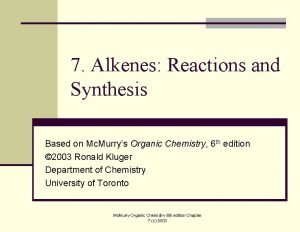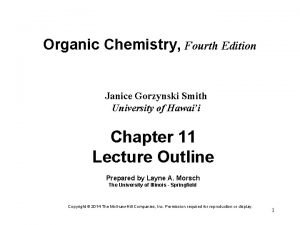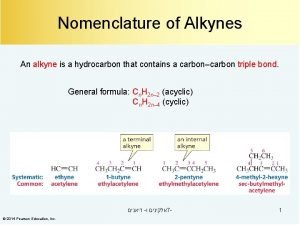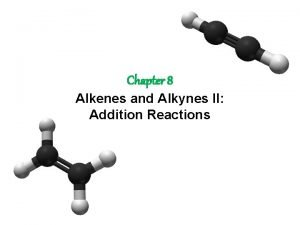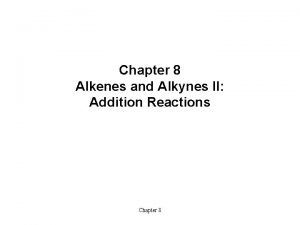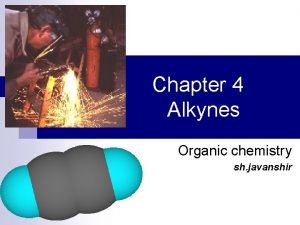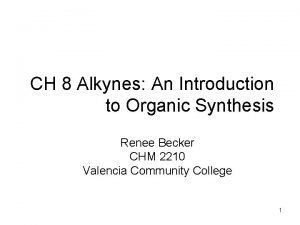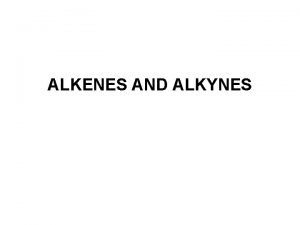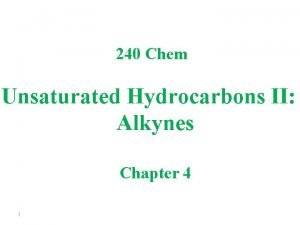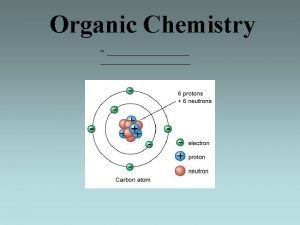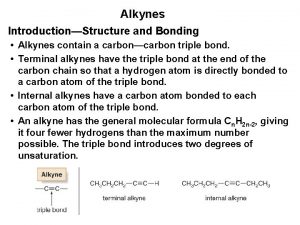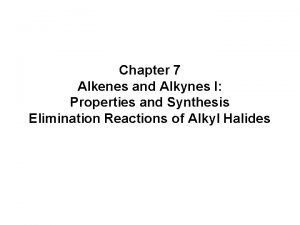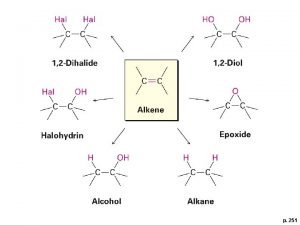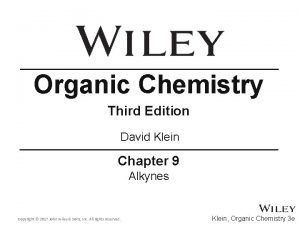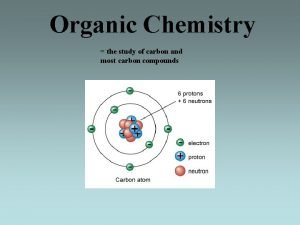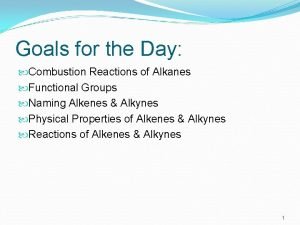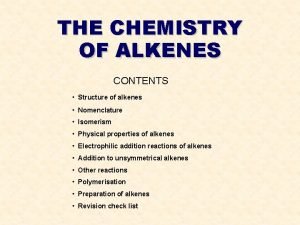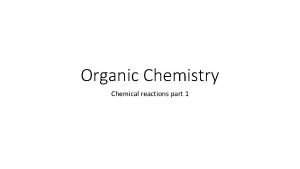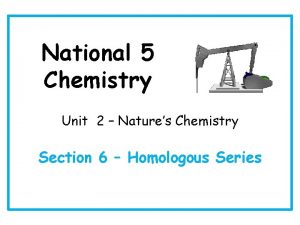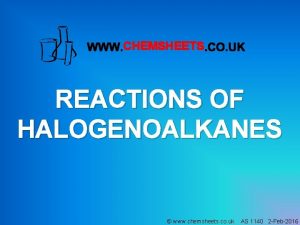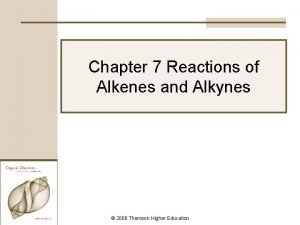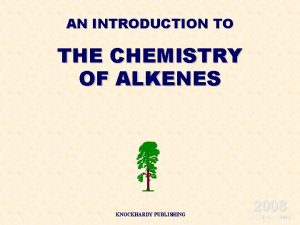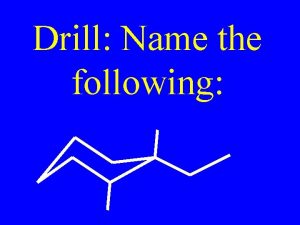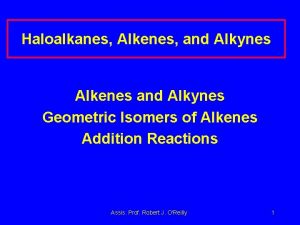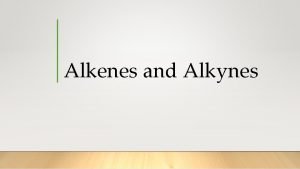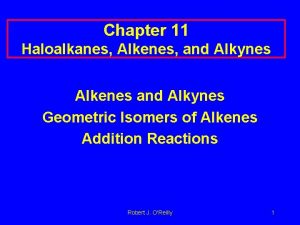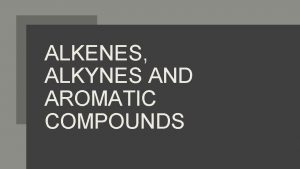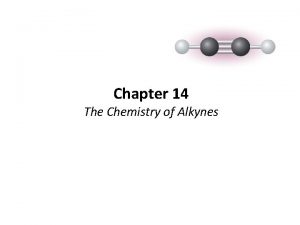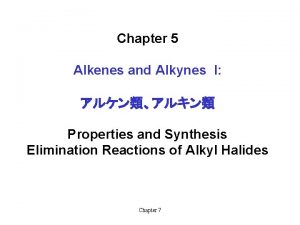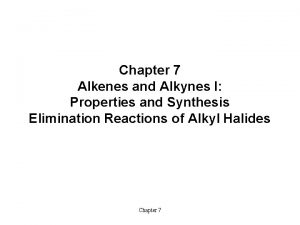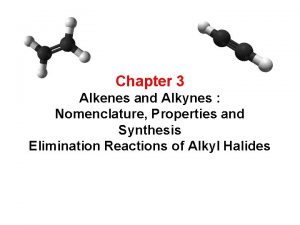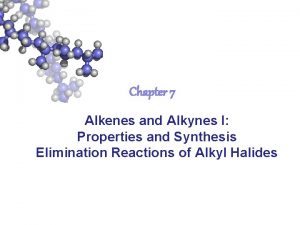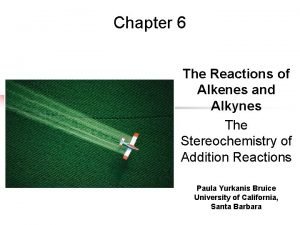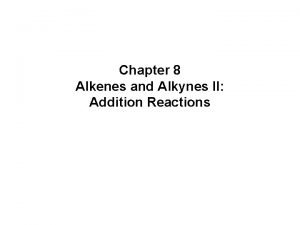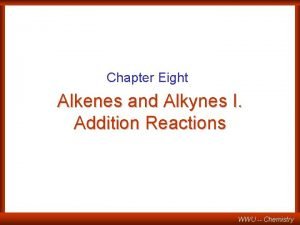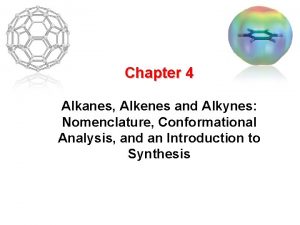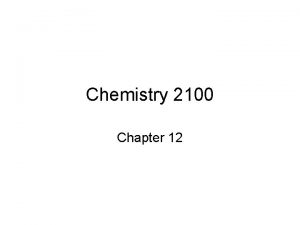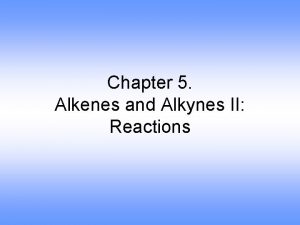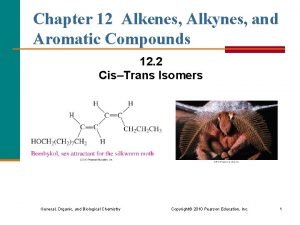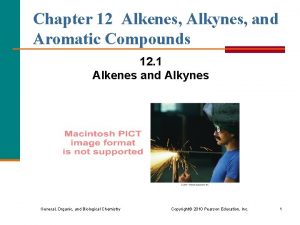Chapter 3 Alkenes and Alkynes Alkenes and Alkynes



























- Slides: 27

Chapter 3 Alkenes and Alkynes

Alkenes and Alkynes • Alkene: a hydrocarbon that contains one or more carbon-carbon double bonds • ethylene is the simplest alkene • Alkyne: a hydrocarbon that contains one or more carbon-carbon triple bonds • acetylene is the simplest alkyne



Alkenes • Structure: • the VSEPR model predicts bond angles of 120° around each carbon of a double bond • in ethylene, the actual angles are close to 120° • in substituted alkenes, bond angles may be greater than 120° because of repulsion of alkyl groups bonded to the double bond

Alkenes • Cis-trans isomerism • because of restricted rotation about a carbon-carbon double bond, an alkene with two different groups on each carbon of the double bond shows cis-trans isomerism

Alkenes - IUPAC Names • To name an alkene • the parent name is that of the longest chain that contains the C=C • number the chain from the end that gives the lower numbers to the carbons of the C=C • locate the C=C by the number of its first carbon • use the ending -ene to show the presence of the C=C • branched-chain alkenes are named in a manner similar to alkanes; substituted groups are located and named

Alkenes - IUPAC Names • Examples No cis-trans isomers

Alkynes - IUPAC Names • follow the same rules as for alkenes, but use the ending -yne to show the presence of the triple bond

Common Names • Common names are still used for some alkenes and alkynes, particularly those of low molecular weight

Cycloalkenes • To name a cycloalkene • number the carbon atoms of the ring double bond 1 and 2 in the direction that gives the lower number to the substituent encountered first • number and list substituents in alphabetical order

Dienes, Trienes, Polyenes • alkenes that contain more than one double bond are named as alkadienes, alkatrienes, and so on • those that contain several double bonds are referred to more generally as polyenes (Greek: poly, many)

Physical Properties • alkenes and alkynes are nonpolar compounds • the only attractive forces between their molecules are London dispersion forces • their physical properties are similar to those of alkanes with the same carbon skeletons • alkenes and alkynes are insoluble in water but soluble in one another and in nonpolar organic liquids • alkenes and alkynes that are liquid or solid at room temperature have densities less than 1 g/m. L; they float on water

Reactions of Alkenes • The most common reaction is addition

Reactions of Alkenes • Most alkene addition reactions are exothermic • the products are more stable (lower in energy) than the reactants • just because they are exothermic doesn’t mean that they occur rapidly • reaction rate depends on activation energy • many alkene addition reactions require a catalyst

Addition of HX • Addition of HX (HCl, HBr, or HI) to an alkene gives a haloalkane • H adds to one carbon of the C=C and X to the other • reaction is regioselective • Markovnikov’s rule: H adds to the less substituted carbon and X to the more substituted carbon


Addition of HX • Chemists account for the addition of HX to an alkene by a two-step reaction mechanism • we use curved arrows to show the movement of electron pairs during a chemical reaction • the tail of an arrow shows the origin of the electron pair (either on an atom of in a bond) • the head of the arrow shows its new position • curved arrows show us which bonds break and which new ones form

Addition of HCl to 2 Butene • Step 1: • reaction of the carbon-carbon double bond with H+ gives a secondary carbocation intermediate • Step 2: • reaction of the carbocation intermediate with chloride ion completes the addition

Addition of H 2 O • Addition of water is called hydration • hydration is acid catalyzed, most commonly by H 2 SO 4 • hydration follows Markovnikov’s rule; H adds to the less substituted carbon and OH adds to the more substituted carbon

Addition of H 2 O • Step 1: • Step 2: • Step 3:

• Addition of Cl 2 and Br 2 Addition takes place readily at room temperature • reaction is generally carried out using pure reagents, or mixing them in a nonreactive organic solvent • addition of Br 2 is a useful qualitative test for the presence of a carbon-carbon double bond • Br 2 has a deep red color; dibromoalkanes are colorless

Addition of H 2 - Reduction • Virtually all alkenes add H 2 in the presence of a transition metal catalyst, commonly Pd, Pt, or Ni

Polymerization • From the perspective of the organic chemical industry, the single most important reaction of alkenes is polymerization • polymer: Greek: poly, many and meros, part • monomer: Greek: mono, single and meros, part

Polymerization • show the structure of a polymer by placing parentheses around the repeating monomer unit • place a subscript, n, outside the parentheses to indicate that this unit repeats n times • the structure of a polymer chain can be reproduced by repeating the enclosed structure in both directions • following a section of polypropene (polypropylene)


Chapter 3 End Chapter 3
 Alkanes alkenes alkynes
Alkanes alkenes alkynes Diol formation from alkene
Diol formation from alkene Halogenation of alkynes
Halogenation of alkynes Naming alkynes
Naming alkynes Oxymercuration demercuration of alkynes
Oxymercuration demercuration of alkynes Addition of halogens to alkenes
Addition of halogens to alkenes Mercury catalyzed hydration of alkynes
Mercury catalyzed hydration of alkynes Mercury catalyzed hydration of alkynes
Mercury catalyzed hydration of alkynes Examples of alkyne
Examples of alkyne Hybridization of alkynes
Hybridization of alkynes Alkynes structural formula
Alkynes structural formula Preparation of alkynes
Preparation of alkynes Alkynes
Alkynes Alkynes
Alkynes Alkyne reactions
Alkyne reactions First 10 members of alkynes
First 10 members of alkynes Enolate
Enolate Combustion reaction of alkanes
Combustion reaction of alkanes Properties of alkenes
Properties of alkenes Incomplete combustion of ethene
Incomplete combustion of ethene Explain homologous series with example
Explain homologous series with example Chemsheets as 1139
Chemsheets as 1139 Rco3h reaction
Rco3h reaction Physical properties of alkenes
Physical properties of alkenes Hybridization of alkenes
Hybridization of alkenes Name the following alkenes
Name the following alkenes Alkene prefix
Alkene prefix Test for alkenes
Test for alkenes

